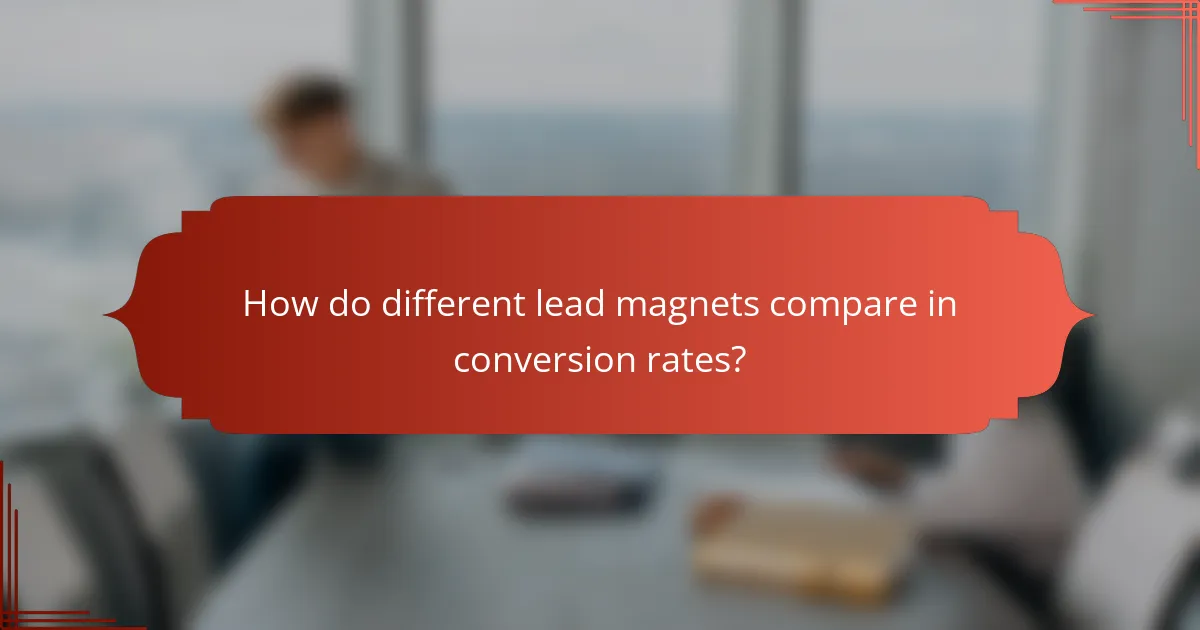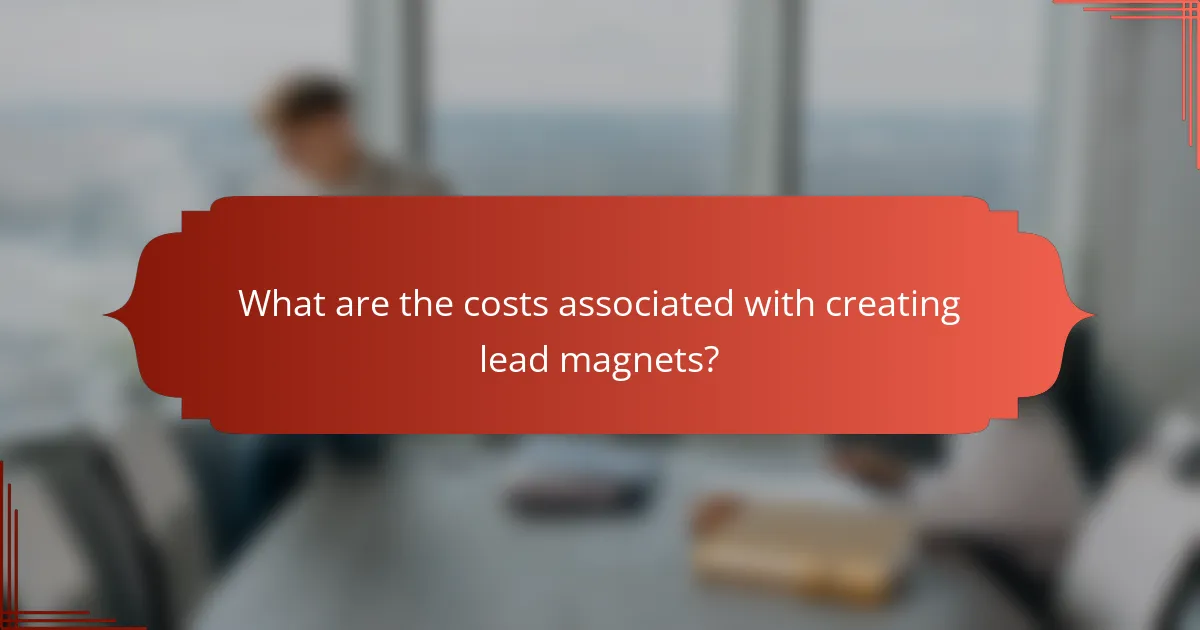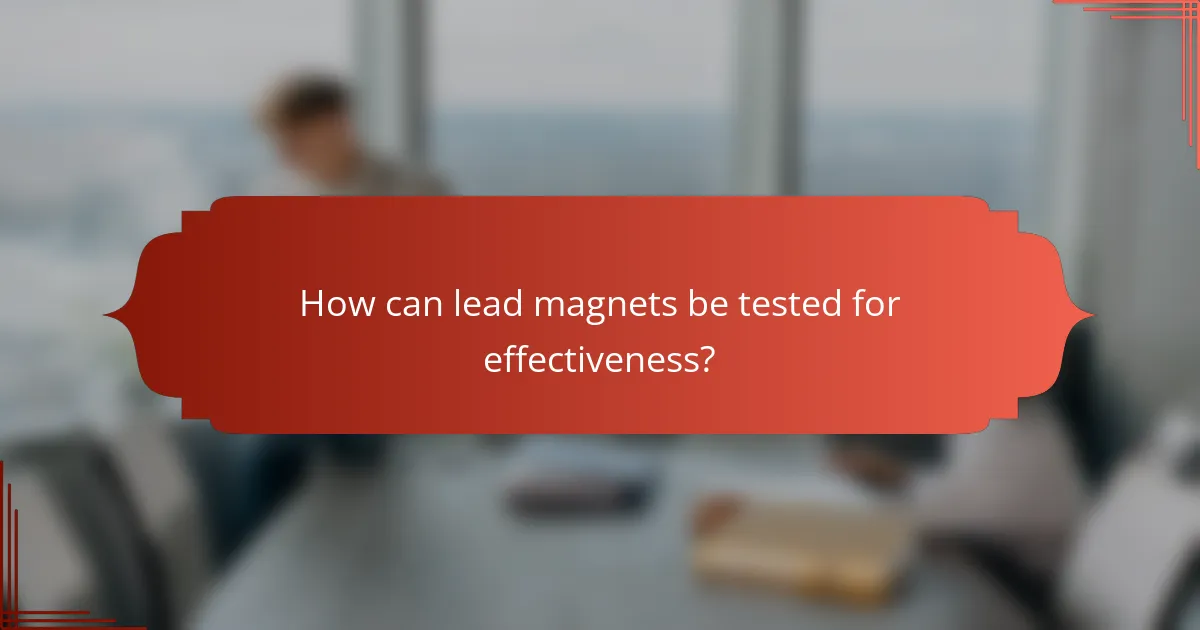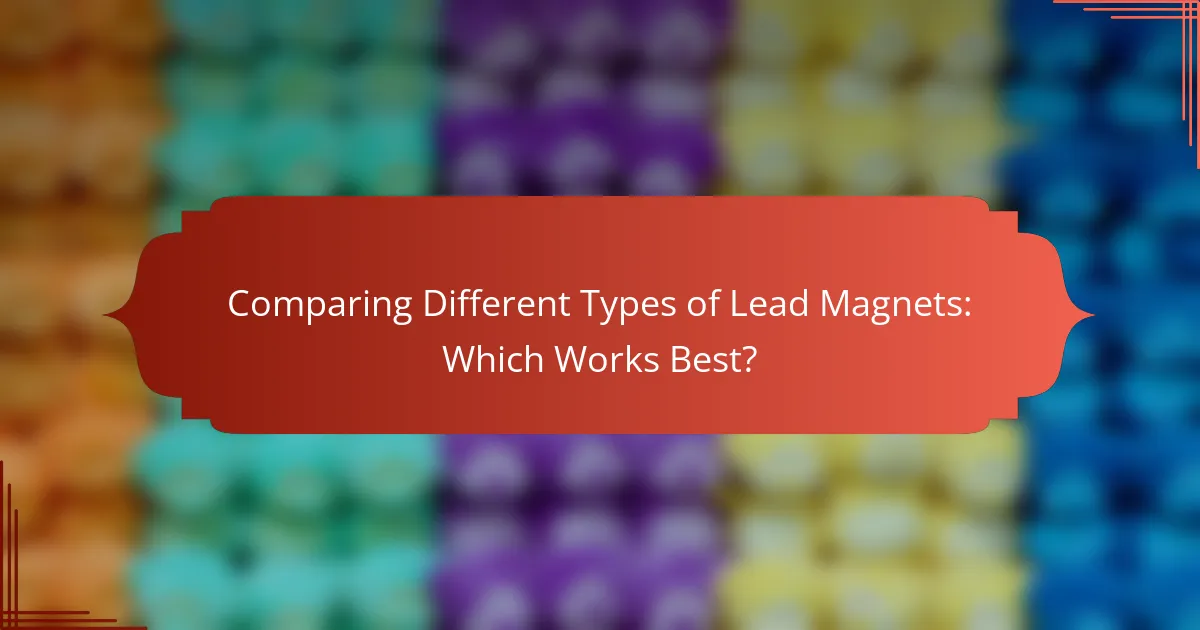Lead magnets are essential tools for attracting potential customers, and their effectiveness can vary significantly based on type and audience. From Ebooks and webinars to quizzes and free trials, each format offers unique advantages that can be leveraged for maximum impact. Understanding your target audience and delivering high-quality content are crucial for optimizing conversion rates and turning leads into loyal customers.

Which lead magnets are most effective in the UK?
In the UK, effective lead magnets typically include Ebooks, webinars, checklists, free trials, and quizzes. Each type has unique advantages and can be tailored to specific audiences for maximum impact.
Ebooks
Ebooks are popular lead magnets that provide in-depth information on a particular topic. They work well for audiences seeking comprehensive insights and can be easily shared across platforms.
Consider creating an Ebook that addresses common pain points in your industry. Offering it in exchange for an email address can significantly boost your subscriber list.
Webinars
Webinars engage potential customers through live or recorded presentations, allowing for real-time interaction. They are effective for educating audiences and showcasing expertise.
To maximize attendance, promote your webinar across social media and email newsletters. Aim for a duration of 30 to 60 minutes to maintain viewer interest.
Checklists
Checklists are straightforward and actionable lead magnets that help users complete tasks efficiently. They are particularly effective for audiences looking for quick solutions.
Design checklists that simplify complex processes in your niche. Ensure they are visually appealing and easy to download to encourage sign-ups.
Free trials
Free trials allow potential customers to experience your product or service without commitment. This approach can lead to higher conversion rates as users can assess value firsthand.
Consider offering a limited-time free trial, such as 14 or 30 days, to create urgency. Clearly communicate the benefits and features available during the trial period.
Quizzes
Quizzes are engaging lead magnets that provide personalized results based on user responses. They can be a fun way to gather information while delivering value to participants.
Design quizzes that relate to your offerings and provide insights or recommendations. Promote sharing results on social media to expand your reach and attract more leads.

How do different lead magnets compare in conversion rates?
Different lead magnets can yield varying conversion rates, often influenced by the target audience and the value offered. Generally, interactive and high-value content tends to perform better, while simpler formats may attract fewer leads.
Ebooks vs Webinars
Ebooks typically serve as downloadable resources that provide in-depth information on a specific topic, appealing to users looking for comprehensive insights. Webinars, on the other hand, offer real-time interaction and engagement, which can lead to higher conversion rates due to the personal connection established during the session.
Consider the audience’s preferences: if they favor self-paced learning, ebooks might be more effective. However, if they appreciate live interaction and Q&A opportunities, webinars could be the better choice. Aim for a conversion rate of around 20-30% for webinars, while ebooks often see rates in the low teens.
Checklists vs Quizzes
Checklists provide straightforward, actionable steps that users can follow, making them appealing for those seeking quick solutions. Quizzes, however, engage users by offering personalized results, which can significantly boost interest and interaction.
When deciding between the two, consider your audience’s engagement level. Quizzes can achieve conversion rates of 30% or more due to their interactive nature, while checklists may see lower rates, typically in the range of 10-15%. Use clear calls to action to enhance effectiveness.
Free trials vs Demos
Free trials allow potential customers to experience a product or service firsthand, which can lead to higher conversion rates as users become familiar with its value. Demos, in contrast, provide a guided overview, showcasing features without the commitment of a trial.
For software products, free trials often convert at rates of 15-25%, while demos may yield slightly lower rates, around 10-20%. Ensure that both options clearly communicate the benefits and include follow-up strategies to convert leads into paying customers.

What factors influence lead magnet success?
The success of lead magnets is influenced by several key factors, including understanding the target audience, ensuring high content quality, and selecting the right delivery method. Each of these elements plays a crucial role in attracting and converting potential leads into customers.
Target audience
Identifying the target audience is essential for creating effective lead magnets. Understanding their preferences, pain points, and interests allows marketers to tailor content that resonates with them. For instance, a tech-savvy audience may prefer in-depth eBooks, while a general audience might respond better to simple checklists or guides.
To effectively reach your audience, consider conducting surveys or analyzing existing customer data. This insight can help refine your lead magnet strategy and ensure it aligns with what your audience values most.
Content quality
High-quality content is vital for lead magnet success. It should provide real value, addressing specific needs or challenges faced by the audience. For example, a well-researched whitepaper can establish authority and trust, while a poorly written piece may deter potential leads.
Focus on clarity, relevance, and actionable insights in your content. Utilizing professional design and formatting can also enhance perceived value, making it more likely that users will engage with and share your lead magnet.
Delivery method
The delivery method of a lead magnet can significantly impact its effectiveness. Common methods include email delivery, downloadable files, or access to exclusive content on a website. Each method has its advantages; for example, email delivery can facilitate immediate engagement, while downloadable files can be saved for later reference.
Consider the preferences of your target audience when choosing a delivery method. Testing different approaches can provide insights into what works best, allowing for adjustments that improve conversion rates over time.

How to choose the right lead magnet for your business?
Choosing the right lead magnet involves understanding your target audience, assessing your available resources, and evaluating your competition. A well-selected lead magnet not only attracts potential customers but also aligns with your business goals and capabilities.
Identify audience needs
Understanding your audience’s needs is crucial when selecting a lead magnet. Conduct surveys or interviews to gather insights on what information or resources they find valuable. For instance, if your audience consists of small business owners, offering a free eBook on effective marketing strategies may resonate well.
Consider segmenting your audience based on their specific interests or pain points. Tailoring lead magnets to these segments can significantly improve engagement rates. For example, a fitness brand might offer different lead magnets for weight loss versus muscle gain.
Assess resource availability
Evaluate the resources you have at your disposal to create and deliver lead magnets. This includes time, budget, and expertise. If you have limited resources, simpler lead magnets like checklists or templates might be more feasible than extensive courses or webinars.
Additionally, consider the tools and platforms you will use for distribution. For example, if your business primarily operates online, ensure that your lead magnet is easily accessible through your website or email marketing software.
Evaluate competition
Analyzing your competition can provide valuable insights into effective lead magnets in your industry. Look at what types of lead magnets competitors are offering and assess their success. This can help you identify gaps in the market or areas where you can differentiate your offerings.
However, avoid simply copying what others do. Instead, aim to enhance or innovate upon existing ideas. For instance, if competitors are offering free trials, consider adding personalized onboarding sessions to make your lead magnet more appealing.

What are the costs associated with creating lead magnets?
Creating lead magnets involves various costs that can significantly impact your overall marketing budget. These costs typically include design expenses, content creation costs, and marketing budgets, each of which plays a crucial role in the effectiveness of your lead magnet.
Design expenses
Design expenses refer to the costs associated with creating visually appealing lead magnets. This can include hiring graphic designers or purchasing design software. Depending on complexity, design costs can range from a few hundred to several thousand dollars.
When budgeting for design, consider whether you will use templates or custom designs. Templates can be a cost-effective option, while custom designs may provide a unique look but at a higher price point.
Content creation costs
Content creation costs encompass the expenses related to writing, editing, and producing the actual content of your lead magnet. This could involve hiring freelance writers, purchasing stock images, or investing in video production. Costs can vary widely, typically falling between a few hundred to a couple of thousand dollars.
To manage these costs effectively, outline your content needs clearly and consider using in-house resources where possible. This can help you save money while still producing quality content.
Marketing budget
The marketing budget is the amount allocated to promote your lead magnet and attract potential leads. This can include paid advertising, social media promotions, and email marketing campaigns. Depending on your strategy, marketing costs can range from modest amounts to significant investments.
To maximize your marketing budget, focus on targeted advertising and organic reach strategies. Analyze your audience to ensure that your promotional efforts are efficient and effective, which can help you achieve better results without overspending.

How can lead magnets be tested for effectiveness?
Lead magnets can be tested for effectiveness through various methods that measure their impact on conversion rates and user engagement. By comparing different versions or types of lead magnets, businesses can determine which ones resonate best with their audience.
A/B testing methods
A/B testing involves comparing two versions of a lead magnet to see which performs better. This method requires splitting your audience into two groups, each receiving a different version of the lead magnet, and then analyzing the conversion rates or engagement metrics for each group.
When conducting A/B tests, it’s essential to focus on one variable at a time, such as the design, copy, or offer type. This allows for clearer insights into what specifically drives performance. For example, you might test a free eBook against a webinar invitation to see which generates more sign-ups.
To ensure reliable results, aim for a sample size that is statistically significant, often in the low hundreds or thousands, depending on your overall traffic. Monitor the test for a sufficient duration, typically a few weeks, to account for variations in user behavior.
